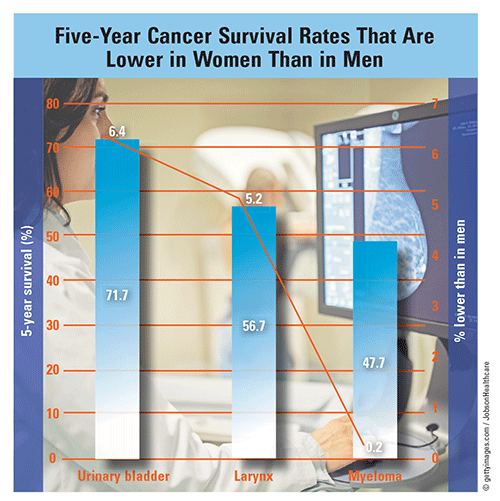US Pharm. 2020;45(9):14.
The Papanicolaou (Pap) test and the human papillomavirus (HPV) test have been proven to prevent cervical cancer, and according to the National Center for Health Statistics, the 5-year survival rate for cervical cancer was 67.5% in 2015. According to the CDC, combined 5-year survival for all cancer types was higher in women than in men (66.8% vs. 65.8%), varying from a marginal difference of 2.1% for thyroid cancer to 40% for lung and bronchus cancer.

Cervical Cancer Screening: In 2015, 70.2% of female patients aged 18 years and older had Pap tests that were ordered or conducted during an office visit (22.6 million visits). Pap testing decreased with patient age, with rates of 76.1%, 75.5%, and 42.3% in the age groups 18 to 44 years, 45 to 64 years, and older than 65 years, respectively. In 2017, 44% of girls aged 13 to 17 years received three or more doses of HPV vaccine.
Mammography: The Preventive Services Task Force has recommended biennial mammography for at-risk women and those aged 50 to 74 years in order to reduce breast cancer mortality. Between 2000 and 2017, the number of new breast cancer cases decreased from 132.8 to 125.1 per 100,000 women. In 2017, the number of new breast cancer cases in women aged 70 to 74 years peaked at 463.5 per 100,000. Although the 5-year survival rate for breast cancer was 89.1%, only 65.3% of women aged 40 years and older had mammograms. In 2015, the screening rate was 58.3% in women aged 40 to 49 years, 71.3% in those aged 50 to 64 years, and 72.2% in those aged 65 to 74 years.
Survival Rates for Other Cancers: Women had higher 5-year survival rates than men for kidney and renal pelvis cancer (73.1% vs. 71.7%, respectively), thyroid cancer (98% vs. 96%), colon and rectal cancer (64.4% vs. 63.1%), pancreatic cancer (9.6% vs. 9.4%), and Hodgkin’s lymphoma (85.4% vs. 82.6%). Female patients with stomach cancer lived significantly longer than their male counterparts (34.6% vs. 28%); the same was true for liver and intrahepatic bile duct cancer (19.6% vs. 17.5%) and brain and other nervous system cancers (34.4% vs. 31.1%). Five-year cancer-survival rates were lower in women than in men for three types of cancer. Survival rates were significantly lower in women than in men for urinary bladder cancer (71.7% vs. 76.6%) and cancer of the larynx (56.7% vs. 59.8%). For myeloma, the difference in 5-year survival between women and men was insignificant (47.7% vs. 47.8%).
The content contained in this article is for informational purposes only. The content is not intended to be a substitute for professional advice. Reliance on any information provided in this article is solely at your own risk.
To comment on this article, contact rdavidson@uspharmacist.com.






